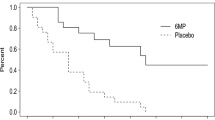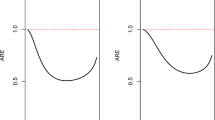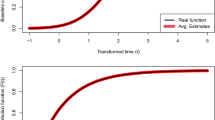Abstract
We propose a new class of semiparametric regression models based on a multiplicative frailty assumption with a discrete frailty, which may account for cured subgroup in population. The cure model framework is then recast as a problem with a transformation model. The proposed models can explain a broad range of nonproportional hazards structures along with a cured proportion. An efficient and simple algorithm based on the martingale process is developed to locate the nonparametric maximum likelihood estimator. Unlike existing expectation-maximization based methods, our approach directly maximizes a nonparametric likelihood function, and the calculation of consistent variance estimates is immediate. The proposed method is useful for resolving identifiability features embedded in semiparametric cure models. Simulation studies are presented to demonstrate the finite sample properties of the proposed method. A case study of stage III soft-tissue sarcoma is given as an illustration.



Similar content being viewed by others
References
American Joint Committee on Cancer (2002) Cancer Staging Manual, 6th edn. Springer, New York
Bickel PJ, Klaassen CA, Ritov Y, Wellner JA (1998) Efficient and adaptive estimation for semiparametric models, 2nd edn. Johns Hopkins University Press, Baltimore
Broët P, Rycke YD, Tubert-Bitter P, Lellouch J, Asselain B, Moreau T (2001) A semiparametric approach for the two-sample comparison of survival times with long-term survivors. Biometrics 57:844–852
Caroni C, Crowder M, Kimber A (2010) Proportional hazards models with discrete frailty. Lifetime Data Anal 16:374–384
Chen MN, Ibrahim JG, Sinha D (1999) A new Bayesian model for survival data with a surviving fraction. J Am Stat Assoc 94:909–919
Chen Y-H (2009) Weighted Breslow-type estimator and maximum likelihood estimation in semiparametric transformation models. Biometrika 96:591–600
Coleman TF, Li Y (1994) On the convergence of reflective Newton methods for large-scale nonlinear minimization subject to bounds. Math Prog 67:189–224
Coleman TF, Li Y (1996) An interior, trust region approach for nonlinear minimization subject to bounds. SIAM J Optimiz 6:418–445
Cormier JN, Huang X, Xing Y, Thall PF, Wang X, Benjamin RS, Pollock RE, Antonescu CR, Maki RG, Brennan MF, Pisters PWT (2004) Cohort analysis of patients with localized high-risk extremity soft tissue sarcoma treated at two cancer centers: chemotherapy-associated outcomes. J Clin Oncol 22:4567–4574
Dabrowska DM, Doksum KA (1988) Estimation and testing in the two-ample generalized odds-rate model. J Am Stat Assoc 83:744–749
Geyer GJ (2009) Trust: Trust Region Optimization. R package 0.1-2
Kalbfleisch JD, Prentice RL (2002) The statistical analysis of failure time data, 2nd edn. Wiley, New York
Lu W, Ying Z (2004) On semiparametric transformation cure models. Biometrika 91:331–343
Mao M, Wang J-L (2010) Semiparametric efficient estimation for a class of generalized proportional odds cure models. J Am Stat Assoc 105:302–311
Murphy SA (1994) Consistency in a proportional hazards model incorporating a random effect. Ann Stat 22:712–731
Murphy SA (1995) Asymptotic theory for the frailty model. Ann Stat 23:182–198
Parner E (1998) Asymptotic theory for the correlated gamma-frailty models. Ann Stat 26:183–214
Peng Y, Dear KBG (2000) A nonparametric mixture model for cure rate estimation. Biometrics 56:237–243
Sy JP, Taylor JMG (2000) Estimation in a Cox proportional hazards cure model. Biometrics 56:227–236
Tsodikov AD, Ibrahim JG, Yakovlev AY (2003) Estimating cure rates from survival data: an alternative to two-component mixture models. J Am Stat Assoc 98:1063–1079
Zeng D, Lin DY (2006) Efficient estimation of semiparametric transformation models for counting processes. Biometrika 93:627–640
Zeng D, Yin G, Ibrahim JG (2006) Semiparametric transformation models for survival data with a cure fraction. J Am Stat Assoc 101:670–684
Author information
Authors and Affiliations
Corresponding author
Appendix: information matrix
Appendix: information matrix
Let \(\{t_j\}\) denote the sets of the observed failure times and \(d\Lambda _j=\Delta \Lambda (t_j)\). Define \(h_i(t;\varvec{\theta })=H_{\varvec{\gamma }}^{\prime }\big (\xi _i(t;\varvec{\beta },\Lambda )\big )\), \(\psi _i(t;\varvec{\theta })=\psi _{\varvec{\gamma }}\big (\xi _i(t;\varvec{\beta },\Lambda )\big )\), \(\phi _i(t;\varvec{\theta })=\phi _{\varvec{\gamma }}\big (\xi _i(t;\varvec{\beta },\Lambda )\big )\), and
The observed information matrix \(\mathcal I \) for the NPMLE can be approximated by (3.8). The closed-form expressions for submatrices for \(\mathcal I \), obtained from the idea of Chen (2009), are presented as follows;
where
For \(j<k\),
By symmetry, \(\mathcal I _{d\Lambda _kd\Lambda _j}\) can also be obtained from the above expression.
where
where
and
Rights and permissions
About this article
Cite this article
Choi, S., Huang, X. & Chen, YH. A class of semiparametric transformation models for survival data with a cured proportion. Lifetime Data Anal 20, 369–386 (2014). https://doi.org/10.1007/s10985-013-9268-2
Received:
Accepted:
Published:
Issue Date:
DOI: https://doi.org/10.1007/s10985-013-9268-2




